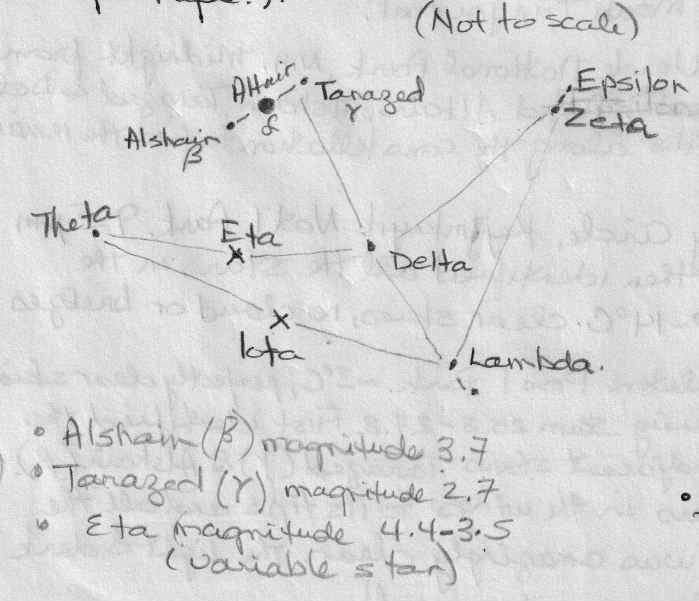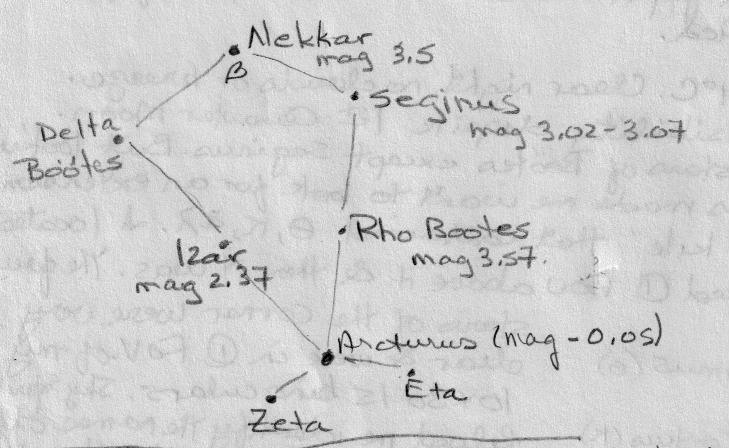Explore the Moon (Binocular) - September 3, 2016
Constellations: Aquila, Boötes, Cepheus, Corona Borealis, Cygnus, Hercules, Lyra, Pegasus, Scorpius, Triangulum, Ursa Minor
Asterisms: Keystone of Hercules, Summer Triangle, Teapot
Messier Objects: M7 (Ptolemy's Cluster), M8 (Lagoon Nebula), M13 (Hercules Cluster), M20 (Triffid Nebula), M21, M45 (Pleaides)
NGC: NGC 869 / NGC 884
Satellites: 3
Meteors: 12
Location: Swiss Air Monument
With Others: Jerry Black
Date: 2016-09-03 to 2016-09-04
Time: 8:00 PM - 2:35 AM ADT
Transparency: not recorded
Seeing: High clouds sometimes limited viewing.
Temp: 16° C - 12° C
Fog and cloud on the low south horizon. Sitting on the rocks with Jerry as he does his astro-imaging and we do some visual observations together. As we were setting up for time-lapse imaging and binocular observing respectively, we watched the crescent Moon go down.
Meteors
Time: 9:00 PM - 1:00 AM ADT
Equipment: Visual
Saw 12 throughout the night. No Moon. One lasted 1-2 seconds, quite bright.
Satellites
- 9:15 PM ADT - Visual
Satellite travelling through Aquila before disappearing - 9:45 PM ADT - Binoculars 10x30 IS. x10 mag
Satellite travelling along then slowly crossing the Milky Way. Very Small and only seen in my binocs before it disappeared. - 10:04 PM ADT - Visual
From Keystone of Hercules to the Milky Way
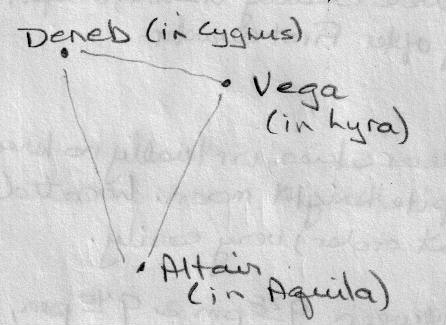 |
Summer Triangle (astronomical asterism) Located the brightest stars in Cygnus, Lyra and Aquila - Deneb, Vega and Altair respectively. |
| Boötes Time: 8:45 PM ADT Equipment: Visual S&T Chart Ref: 42, 44, 53, 55 Located the Big Dipper then arced to Arcturus to locate and identify the stars in this constellation. |
|
Ursa Minor
Time: 8:50 PM ADT
Equipment: Visual + Binoculars 10x30 IS
Magnification: x10
S&T Chart Ref: 41, 51
No low clouds but occasional high clouds impeded the view. Located the North Star (Polaris) then followed the stars to the bucket. I could easily see Zeta, β and Gamma UMi but not Eta UMi. This was the second night I had difficulty seeing it.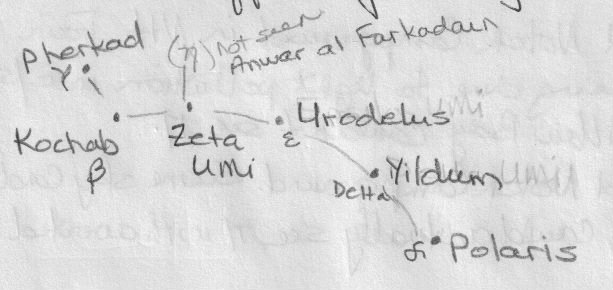
Cepheus (The King)
Time: 8:53 PM ADT
Equipment: Visual
S&T Chart Ref: 71, 73
Found between Cassiopeia and Cygnus, adjacent to Polaris. I knew Cepheus' roof pointed towards Polaris, so began my visual search near Cassiopeia and Polaris. Found it! I only looked for the stars that were brightest and formed the "house". Must look for other stars on a clearer night and when light pollution is not a factor.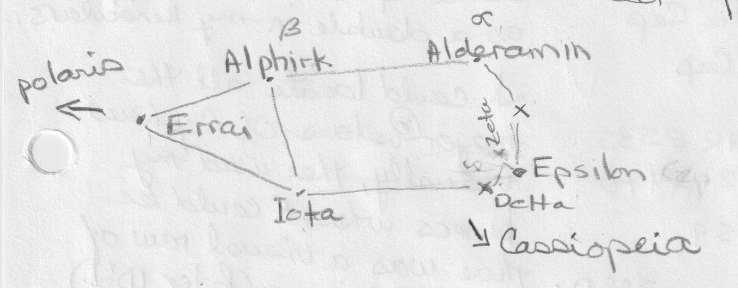
NGC 869 / NGC 884
Time: 9:08 PM ADT
Equipment: Binoculars 10x30 IS
Magnification: x10
S&T Chart Ref: 1, 2, 13
Viewed this with Jerry. Confirmed I knew how to find the double cluster.
Sagittarius
All stars of the Teapot were easily seen above the clouds on the horizon. Mars, Saturn and Antares were in close proximity.
M7: (Ptolemy Cluster, NGC 6475)
Time: 9:18 PM
Equipment: Visual
Magnification:
S&T Chart Ref: 58, 67, 69, I
Easily found it visually as a very large and bright object with direct vision and even brighter with averted vision. Although close to Scorpius, found it easier to find using the Teapot. Numerous stars with very bright core and those outside the core were equally as bright. Not as resplendent as the Pleiades - but close!
M8: (Lagoon Nebula)
Time: 9:27 PM
Equipment: Binoculars 10x30 IS
Magnification: x10
S&T Chart Ref: 67, 69, I
Started at Kaus Australis and continued to the mid-point of the spout, then an equal distance again to M8 (or extend the line from the spout 2 FOVs). A line of 5 bright stars highlighted the object and its oblong shape. Through binoculars, I could see the brightness and the grey of the surrounding stars. In same FOV as M20.
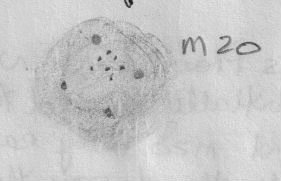 |
M20: (Trifid Nebula) Started at Kaus Australis in the Teapot and continued to the mid-point of the spout, then an equal distance again to M20. In same FOV but just slightly above M8. The stars didn't appear as bright as those in M8. Looked like the brighter stars formed a shape similar to M13 then had a large grouping just off-centre. Star field looked somewhat circular and a fuzzy grey. |
M21:
Time: 9:27 PM
Equipment: Binoculars 10x30 IS
Magnification: x10
S&T Chart Ref: 67, 69, I
Found M20 and M21 in close proximity and in same FOV. Given their proximity, wasn't sure that both were seen versus only M20. There was a small greyish, mottled area NE of M20 that led me to believe I did see it. Couldn't discern bright stars in M21 as I had in M20. I didn't sketch it.
M13: (Hercules Cluster)
Time: 10:13 PM
Equipment: Visual + Binoculars 10x30 IS
Magnification: x10
S&T Chart Ref: 52, 54
Found Corona Borealis then the Keystone of Hercules then M13 with direct vision then with the 10x30 binoculars.
M45: (Pleiades)
Time: 11:00 PM
Equipment: Visual + Binoculars 10x30 IS
Magnification: x10
S&T Chart Ref: 14, 15, A
Because of the light pollution towards Halifax, we had to wait until it was higher in the sky to observe (~ 60°). Used averted vision to view it brighter in the sky than seen by direct viewing. Binoculars allowed viewing of the brighter "sisters" and "parents" with some of the secondary stars within. Viewed this at 11 PM and again at 2:05 AM.
Triangulum:
Time: 11:00 PM
Equipment: Visual
S&T Chart Ref: 2, 4
Confirmed I knew how to find the constellation as taught by Dave Chapman. Due to light pollution from Halifax, had to wait until it was higher in the sky to observe.
Pegasus & Square of Pegasus
Time: 12:22 AM
Equipment: Visual
S&T Chart Ref:74, 75
I located the Square of Pegasus using Cassiopeia and Andromeda as markers. I was able to see the stars o fate Square, plus some of the other stars of the constellation, but not all. I think I found Enif.
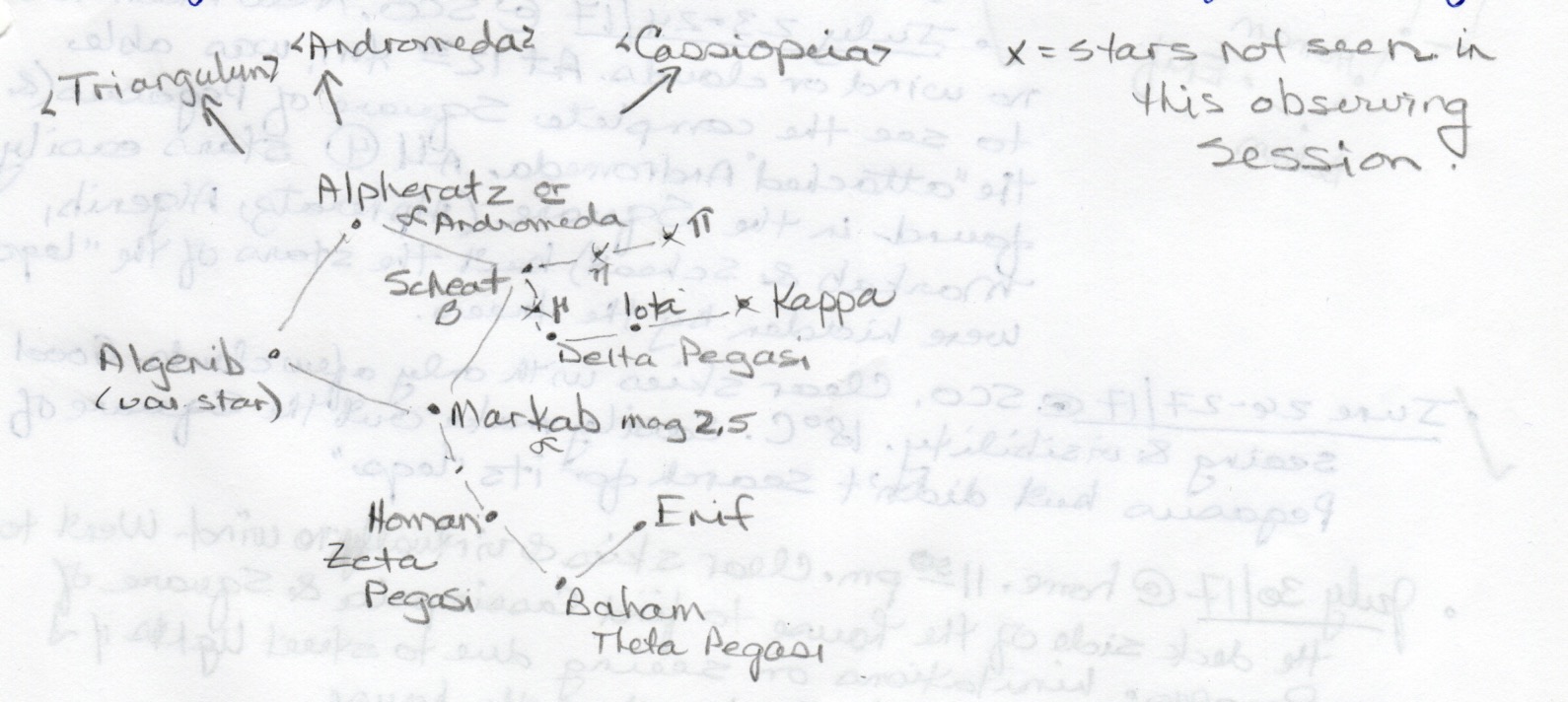
Aquila: (The Eagle)
Time: 1:18 AM
Equipment: Visual
S&T Chart Ref: 64, 65, 66
Sitting and looking at St. Margaret's Bay, I remembered Chris Young saying Altair was in the Eagle (Aquila). This evening, Aquila with its adjacent stars β and γ (gamma) were evident. Looking at SkySafariPro, we determined the location of the other stars in the constellation. We were pleased/thrilled that we were able to find the 3 stars in the head of the Eagle as well as θ (theta), λ (lambda), δ (delta), and ζ (zeta). Didn't search for Eta or Iota (another time?).